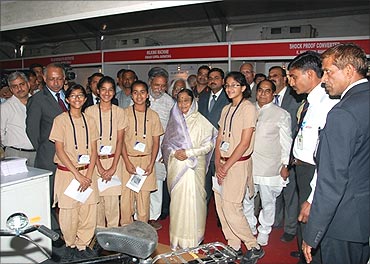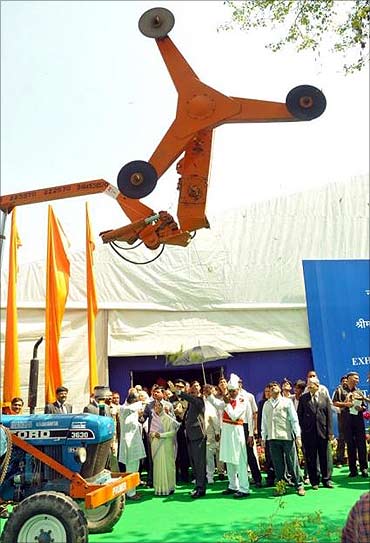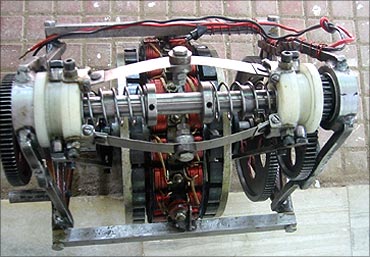Photographs: Courtesy, NIF. Anil Gupta
A black box for automobiles, low-cost solar water heater, power generation from biogas using a bike, an improved apparatus for ultrasonography, etc are part of a treasure trove of projects done by students in techpedia.in. Linking young technological minds with unsolved problems of society is our next agenda, says Anil Gupta.
Given the diversity and the plurality of the Indian society, Indian models of innovations cannot but reflect its culture of resistance, redefining the context and rebuilding the connections among different streams of ideas.
Mughal emperor Akbar tried to synthesise the good practices of different religions in what he called as Deen-e-Elahi and he failed. May be, if had tried to nurture the secular institutions of each sacred belief system, he might have succeeded.
While designing models of innovations for distributed knowledge management, the Honey Bee Network has been very conscious of keeping identity of ideators intact. And still, it has tried to forge cooperation and development of value chain around different idea streams.
We have scouted more than 150,000 ideas, innovations and traditional knowledge practices (not all unique or distinctive) from over 500 districts all over the country.
This is part one of a two-part series on techpedia.in.
Anil K Gupta is a professor at IIM Ahmedabad, Co-ordinator SRISTI and Honeybee Network, and Executive Vice Chair, National Innovation Foundation.
. . .
Innovation: 1 lakh projects for low-cost solutions
Image: Gurmail Singh's pruner being demonstrated before the the President at the Innovation Exhibition.Photographs: Courtesy, NIF.
And then, within the next 10 years, we reached the current number of over 100,000 with the help of various Honey Bee Network collaborators and civil society members and NGIs (non-governmental individuals) through National Innovation Foundation. A new platform, SRISTI has developed through primarily its own resources, techpedia.in.
It has more than 100,000 projects done by 350,000 technology students (mainly final year engineering students) from over 500 institutions including IITs, NITs and many other colleges. This could be done just in about a year.
. . .
Innovation: 1 lakh projects for low-cost solutions
Image: An low-cost tractor.Photographs: Courtesy, NIF.
But in India, disregarding the indifference of the Union ministry of human resource development, the All India Council for Technical Education (AICTE), or the University Grants Commission (UGC), such a platform already exists.
So what does it enable in terms of growth of ideas and innovations which would not have been possible without it? It makes it very difficult for a student to do what has already been done.The innovation quotient thus has gone up and so has the originality quotient.
The search cost for the new students, MSME entrepreneurs, other companies looking for talent, ideas to invest in or join hands with, has gone down enormously.
. . .
Innovation: 1 lakh projects for low-cost solutions
Image: Wind mill-operated power generator.Photographs: Courtesy, NIF.
The innovations at grassroots level have also been posted under the window of 'innovations waiting to be augmented' for those who wish to add value to existing ideas of farmers, artisans, roadside mechanics or others.
Many techfests at different technology institutions have begun to include such value-addition as one of the contests to gauge groundedness of the Indian genius among the tech-savvy youth.. . .
Innovation: 1 lakh projects for low-cost solutions
Image: A black box for automobiles.It is obvious that not many projects will become products in a single cycle of six to nine months. It is here that the kho-kho model has been put forward.
For example, four girls at a Government Women Polytechnic developed a black box for automobile (something that no Indian car has yet, although insurance companies would sure love to have the black box data while settling claims). Another group of students at an engineering college in Nagpur has taken it forward to add value by bringing several new concepts of information processing.In a few cycles of kho-kho, it is likely to become a product with benefits being shared among all the contributors so that more and more collaborative innovations emerge through this platform.
. . .
Innovation: 1 lakh projects for low-cost solutions
Image: Many interesting examples of applied technologies.Not many purveyors/scholars of innovations would have expected original ideas to emerge from polytechnics -- one of the most neglected institutions.
And yet, one finds so many interesting examples of applied technologies whether dealing with RFID, laser, sensor, etc., at such institutions.
New hotbeds of innovations in small towns and small institutions are emerging which planners can continue to neglect because of their myopia.On laser and sensor applications, one would come across about 1800 projects from all over the country with both or one of these features.
The moment one looks at the name of the colleges which come up, a new breakthrough model of collaboration across time, space, and sectors and social segments starts emerging.
. . .
Innovation: 1 lakh projects for low-cost solutions
Image: Transforming the Indian story.Photographs: Courtesy, NIF.
The fact that this story is unfolding without help of government or private sector so far shows that when it comes new ideas, the role of SRISTI in spawning new models and platforms such as NIF and Grassroots Innovation Augmentation Network (GIAN) will continue to remain pivotal.
However, the full potential of techpedia.in cannot be realized without active involvement and ownership of the platform by the young technology leaders in different technical universities, MSME clusters, and other science and technology institutions.
The future challenges will be shared in the next column.
Till then, connect, collaborate and create new solutions through kho-kho and other match making options at techpedia.in.
Watch this space for Part-II of this article on Monday!








article